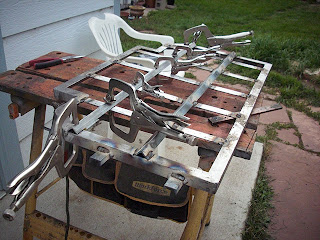I finished the battery box lids this weekend. First, I found that the epoxy I used just did not have enough shear strength - the shear force I put on the hold-downs while I used a router to cut grooves for interconnects to pass under was enough to pop some of the hold-downs off the acrylic top. So, it's nuts and screws for the hold-downs to augment the epoxy. All of the screws and nuts are countersunk so that they don't have any chance of interfering with anything:
Next, I applied 3/16"-thick foam weatherstripping to the acrylic lids. This is to provide some vibration resistance, as well as some resilience so that everything stays nice and tight under compression. Here is the lower rear cover (you can see some of the gaps that I routed out in this picture as well):
Finally, I also applied the 3/16"-thick foam to the metal box tops. Again, to reduce vibration and to keep everything tight when compressed with the nuts/bolts that hold this all together:
One last step before battery interconnecting - I need to add material to keep the cells in-place horizontally (they don't quite fill up the space that the former AGM-1280T batteries occupied).





















































